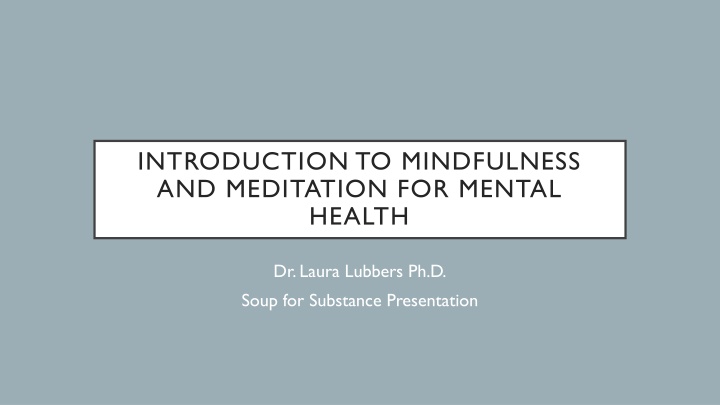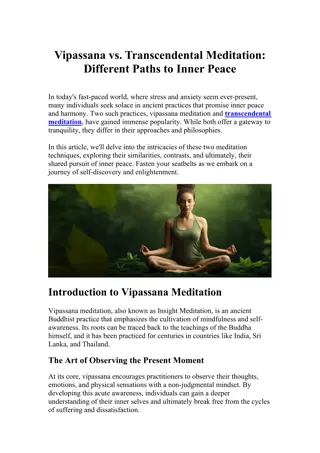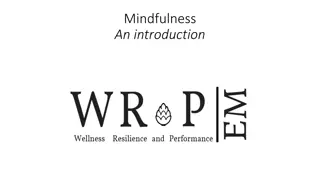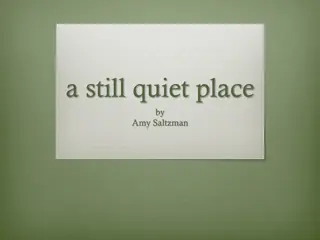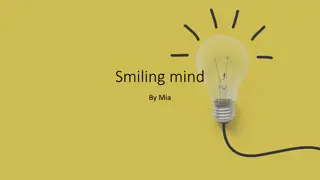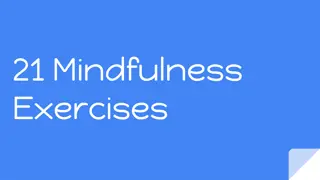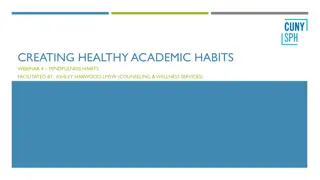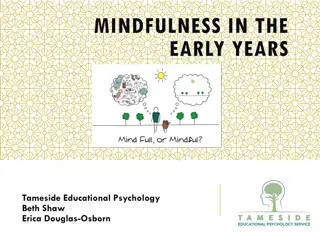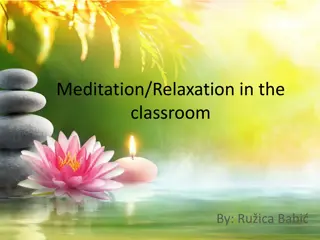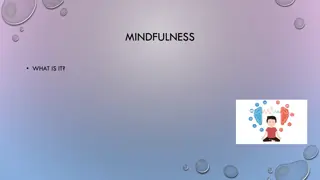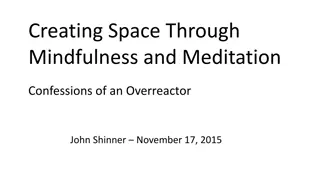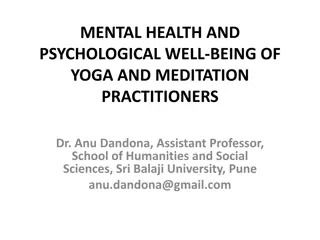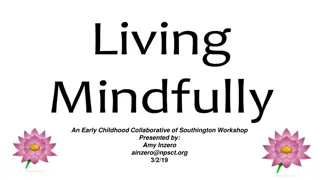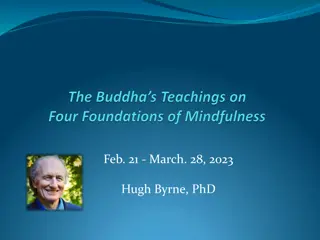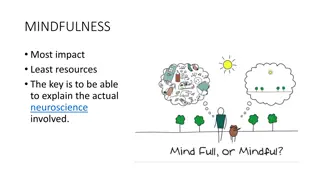Introduction to Mindfulness and Meditation for Mental Health
Explore the definitions, benefits, and practices of mindfulness and meditation in this insightful presentation by Dr. Laura Lubbers. Understand the difference between relaxation techniques and mindfulness practices, and learn how mindfulness and meditation can benefit mental health, reduce stress, improve emotional well-being, enhance focus, and promote better relationships. Discover various types of meditation and how they can positively impact college students and staff by improving time management, mood, stress reduction, sleep, focus, and overall wellness.
Download Presentation

Please find below an Image/Link to download the presentation.
The content on the website is provided AS IS for your information and personal use only. It may not be sold, licensed, or shared on other websites without obtaining consent from the author.If you encounter any issues during the download, it is possible that the publisher has removed the file from their server.
You are allowed to download the files provided on this website for personal or commercial use, subject to the condition that they are used lawfully. All files are the property of their respective owners.
The content on the website is provided AS IS for your information and personal use only. It may not be sold, licensed, or shared on other websites without obtaining consent from the author.
E N D
Presentation Transcript
INTRODUCTION TO MINDFULNESS AND MEDITATION FOR MENTAL HEALTH Dr. Laura Lubbers Ph.D. Soup for Substance Presentation
OBJECTIVES Education about mindfulness and meditation Definitions Benefits types Introduction to various beginning practices Strategies/ skills Time for questions
MINDFULNESS DEFINED Paying attention in a particular way: on purpose, in the present moment, and nonjudgmentally. Kabat- Zinn, 1994 Meditation is practiced in numerous religious and spiritual traditions.
MEDITATION DEFINED CONT. Meditation is an experience of relaxing the body, quieting the mind, and awakening the spirit. Encourages deepening of consciousness and awareness and facilitates deeper understanding of self and others.
MINDFULNESS/ MEDITATION VS. RELAXATION Relaxation training Mindfulness / meditation training Specific skills designed to assist in having increased control over the body/mind response to stress Stress reduction is the focus Attempts to replace stressful, unwanted feelings with a feeling of relaxation The goal is to strengthen the capacity for an attentive mind. Relaxation is often a side effect of the practice but is not the intended goal. Attempt is to tolerate and observe unwanted feelings with acceptance and compassion.
BENEFITS OF MINDFULNESS AND MEDITATION Reduces stress Controls anxiety Promotes emotional health Enhances self awareness Lengthens attention span Improves Memory Promotes gratitude and compassion Improves sleep
BENEFITS OF MINDFULNESS/MEDITATION FOR COLLEGE STUDENTS & STAFF Improves time management Reduces addictions Improves mood Improves stress reduction and sleep Increases focus Improves athletic performance Enhances the immune system Improves relationships with others (peers, coworkers, etc.)
TYPES OF MEDITATION Calming vs. insight oriented meditation Mindfulness meditation Transcendental (mantra) meditation Guided meditation (guided imagery) Loving kindness- well wishes for self and others Yoga meditation Focused breathing/ breath box (inhale hold- exhale-hold) Forest bathing- nature focused meditation
TYPES OF MEDITATION CONT. Walking meditation- labyrinths Mandala meditations
SAMPLE FOCUSES OF MEDITATION Building self compassion Building empathy Increasing positive self regard Examining personal beliefs and values Evaluating life s progress personally and professionally Tolerating difficult emotions Transformative tool to assist with healing (religion/ spirituality/ rituals) To deepen our experiences of gratitude and joy
DEEPENING GRATITUDE AND JOY Gratitude journal Train your mind to focus on things you re thankful for Soak in a positive experience, stay present, don t quickly dismiss
FOUNDATIONS OF MINDFUL MEDITATION Beginners mind: seeing things as new and fresh, as if for the first time, with a sense of curiosity. Non-Judgement: cultivating impartial observations in regards to our experiences. Not labeling thoughts, feelings or sensations as good or bad, right or wrong, but simply taking note of thoughts, feelings and sensations in each moment. Self-Compassion: Cultivating compassion for yourself without self blame or criticism
IMPORTANCE OF THE BREATH The breath is centerpiece of mindfulness and meditation because it connects the mind and body. Irregular shallow breathing vs. settled, calm regular and slowed breathes Focusing on the natural pattern of inhalation and exhalation providers a natural object of meditation The mind becomes more tranquil and aware. Whenever you get lost- bring it back to the breath
MEDITATIONS FOR EMOTIONS Increase emotional awareness/ improve self responsiveness Learn to TOLERATE not distract from challenging emotions FEEL-DEAL-HEAL Increase self-compassion in response to emotions Being mindful of emotions helps us to stand back, understand emotions. Not fear them or struggle against them- which results in decreased distress.
STOP METHOD FOR RESPONDING MINDFULLY Stop During the day make a conscious, committed decision to stop and practice mindfulness Take a break Turn your attention inward, close your eyes, and breathe fully in and out of your lungs Observe Recognize what you are feeling, try naming it Take distance from this feeling or emotion Observe the feelings as if they are fireflies around you allow yourself to be touched by them notice when they are bright or dull just notice Remind yourself that your feelings are part of your experience, they are normal, they do not define you. Proceed Accept whatever you are feeling. Tell yourself no feeling is forever, this will pass, nothing needs to happen for this to be complete.
BEGINNING PRACTICE Mindful Check-ins 2-3 min / 2-3 times a day Ask yourself : How am I doing, what do I need right this moment? Can be used as transitions in between various roles (i.e. class, patients, study sessions, etc.) Above mindful check in 5 min mindful meditation breathwork for centering and grounding Visualize the transition, leaving previous things at the door, walking into the new space- BREATHE
COLORING MANDALA ACTIVITY Color a mandala to tap into your creativity The process of drawing and coloring can focus and nourish you Start with three deep cleansing breaths Breathe in love and breathe out tension and fear Notice the thoughts that come up as you complete your coloring. Notice them and let them go When done notice the shapes and colors and how they make you feel
ADDITIONAL AWAYS TO PRACTICE MINDFULNESS AND MEDITATION 1-2 min of mindful breathing upon waking- don t let your mind race to what you have to do right away When you arrive at your destination take a few in to orient yourself with cleansing breaths breathe consciously and calmly Become aware of subtle signs of tension and take a break to walk or stretch As you wind down let go of today and again do 1-2 min of mindful breathing Develop a mantra or affirmation
INTRODUCTORY APPS/ RESOURCES Headspace Calm App Yoga with Adriene (body movement, intentional mindful breathing recordings) Insight timer Simple Habit Ten Percent Happier Meditation
COUNSELING CENTER INFORMATION Phone 414 288 7172 Walk in or phone triage consultations 8-430 M-F Walk in or phone crisis services M-F 8-430 or after hours by calling 414-288-6800 Location: Holthusen Hall 2ndFloor
QUESTIONS? Thank you for attending! What questions do you have?
